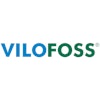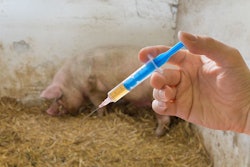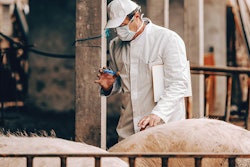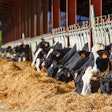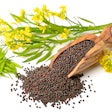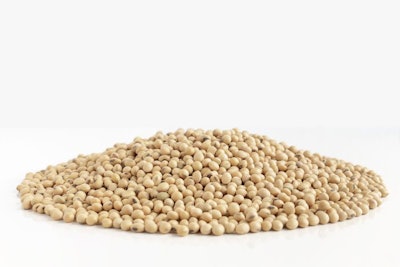
The outer part of the soybean is increasingly being retained as a roughage for ruminants and gestating sows, replacing more expensive fiber sources.
Fibers have received much attention as part of an antibiotic-free program for piglets. The focus has largely been on insoluble fibers that act on the upper gastrointestinal part where they provide motility, water control and a general boost in gut health.
Fermentable fibers, on the other hand, are more beneficial in the lower gut segment where they can act as substrate (food) to beneficial bacteria. These two fibers are not the same, but they both need to be present in piglet feeds at the right amounts.
Insoluble and fermentable fibers
Insoluble fibers are not totally inert. They are largely non-fermentable, but they have an active role to play. Insoluble fibers include lignins, celluloses and some hemicelluloses. In contrast, fermentable fibers are easily dissolved in the aqueous environment of the gut, but not all increase viscosity to the same degree. For example, pectins increase viscosity more than hemicelluloses, but pectins tend to be more fermentable by bacteria than most hemicelluloses. Other minor fibers, such as gums, are not considered here for practical purposes as they are but an insignificant minority in most common feed ingredients.
Benefits of fermentable fibers
Fermentable fibers, including non-digestible oligosaccharides, pectins and most hemicelluloses, bypass intact the stomach and small intestine segments as the animal does not secrete enzymes suitable for their digestion. This is not the case for gut bacteria inhabiting the large intestine of the animals. These bacteria, mostly beneficial ones like Bifidum bacteria and lactic acid-producing bacteria, secrete fiber-digesting enzymes and absorb the released simple sugars. In turn, they excrete organic acids (volatile fatty acids such as acetic, propionic and butyric acids, or lactic acid) that are the end products of their metabolism.
In this way, the end products of beneficial bacteria become a treasure for the host animal. These acids first help reduce local pH, making the environment hostile for pathogenic bacteria such as E. coli. Absorbed organic acids serve as an energy source through the Krebs cycle – and piglets are always in an energy deficient state. In addition, butyric acid in particular has a unique trophic effect on gut villi, making it especially important for restoring gut damage due to starvation, toxins, inflammation, etc. Finally, as beneficial bacteria grow preferentially, they consume all available protein, further depleting substrates for pathogenic bacteria that inhabit the end segment of the large intestine.
Fiber profile in soy hulls
Soy hulls are the outer part of the soya bean that is removed before oil extraction. Most soy hulls are added back to the final meal to produce the normal 44% crude protein soybean meal.
Increasingly, however, they are being retained as a roughage for ruminants and gestating sows, replacing more expensive wheat bran and other high-fiber sources. They are extremely palatable and, if given ad libitum, calves tend to bloat from overconsumption. Using them as a source of fibers for piglet feeds is something that is being investigated.
Soy hulls contain a good amount of insoluble fiber (about 70%), mostly hemicelluloses and celluloses. They are, however, unique in that they are one of the few rich sources of pectins among common feed ingredients. Indeed, they contain about 10% pectins, placing them second to sugar beet pulp (about 20%), a favored ingredient in terms of fermentable fibers. Sugar beet pulp, however, is only locally and then mostly seasonally available, whereas soy hulls are available worldwide, year-round, at competitive prices.
A new development in feeding soy hulls in piglet diets is their treatment with enzymes that increases the amount of fermentable fiber. Although the exact process remains a trade secret, it is not unreasonable to assume that it is the hemicelluloses that are being affected the most to become more rapidly fermented. This has a double advantage as hemicelluloses are also viscous, something we want to avoid as much as possible. Thus, soy hulls with extra fermentable fiber through enzymatic digestion is one more smart feed ingredient that can help in antibiotic-free feeding programs.
Soy hulls and bacterial protein fermentation
Excess protein that escapes the beneficial bacteria of the upper large intestine segment not only feed pathogenic bacteria at the end of the large intestine, but they also contribute to ammonia production, with ammonia being toxic and detrimental to gut architecture. A trial with enzymatically treated soy hulls revealed that two indexes of bacterial protein fermentation decreased significantly compared with control. The concentration of branched-chain fatty acids dropped by 23% (from 1.7% to 1.3% of total short-chain fatty acids), whereas the concentration of indole was reduced by 59%.
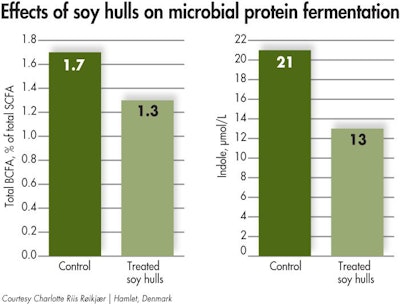
Enzymatically treated soy hulls reduced microbial protein fermentation indexes at the large intestine of pigs, leading to improved overall gut health. (Courtesy Charlotte Riis Røikjær | Hamlet, Denmark)
Given the fact that modern piglet diets are formulated with rather high levels of soybean products, this is indeed good news in controlling any excess crude protein, while avoiding the need for extremely low protein diets.
Link between butyric acid and ZnO supplementation
There is a general trend today to feed less additives, not only because they increase cost and perhaps metabolic burden to the animal, but also because of there is a preference for a clean diet. A clean diet also contains few if any anti-nutritional factors, something that negates the need for additives that restore damage caused by such anti-nutritional factors. Instead, there is a preference for refined ingredients that can provide similar benefits without increasing cost by promoting animal gut health instead of looking to restore it afterwards.
Soy hulls can become a viable alternative to added butyric acid as internal production of this acid ensures butyric is available at the site where it is needed, without increasing cost as fermentable fibers are already accounted for in terms of cost.
Quite interesting is also the case of zinc oxide. Can we replace zinc oxide with fibers? If we consider that pharmacological dosages of zinc oxide largely controlled the overgrowth of all bacteria creating a stable environment, then it may not be unreasonable to assume that the right fibers can achieve the same result if fed at the right amount and balance. It is indeed a very interesting proposition.
Soy hulls, especially when treated with enzymes to increase the concentration of fermentable fibers, are one more source of functional fibers with prebiotic activity suitable for young piglet feeds. This is a new field of research where such an ingredient can be used to replace older methods of controlling gut health in a more animal- and environmentally friendly approach.

